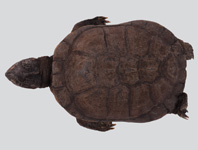Abstract
Using nearly range-wide sampling, we analyze up to 1848 bp of mitochondrial DNA of 183 helmeted terrapins and identify a minimum of 12 deeply divergent species-level clades. Uncorrected p distances of these clades equal or clearly exceed those between the currently recognized species of Pelusios, the genus most closely related to Pelomedusa. We correlate genetic discontinuities of Pelomedusa with data on morphology and endoparasites and describe six new Pelomedusa species. Moreover, we restrict the name Pelomedusa subrufa (Bonnaterre, 1789) to one genetic lineage and resurrect three further species from its synonymy, namely P. galeata (Schoepff, 1792), P. gehafie (Rüppell, 1835), and P. olivacea (Schweigger, 1812). In addition to these ten Pelomedusa species, we identify two further clades from Cameroon and Sudan with similar levels of genetic divergence that remain unnamed candidate species. We also note that some problematical terrapins from South Africa and Somalia may represent two additional candidate species. Some of the Pelomedusa species are morphologically distinctive, whilst others can only be identified by molecular markers and are therefore morphologically cryptic taxa.

